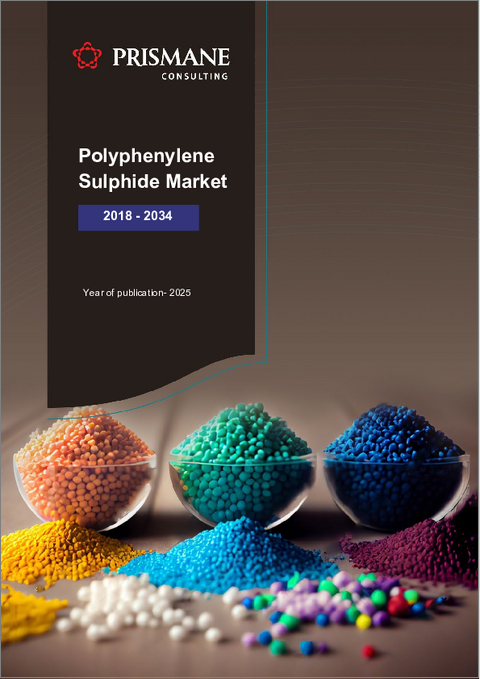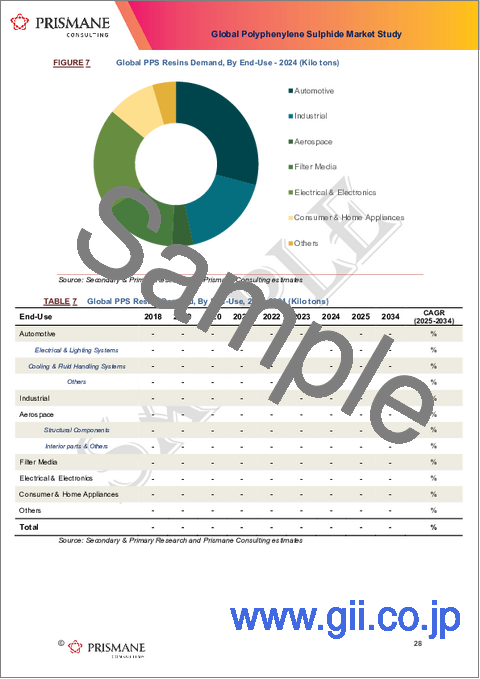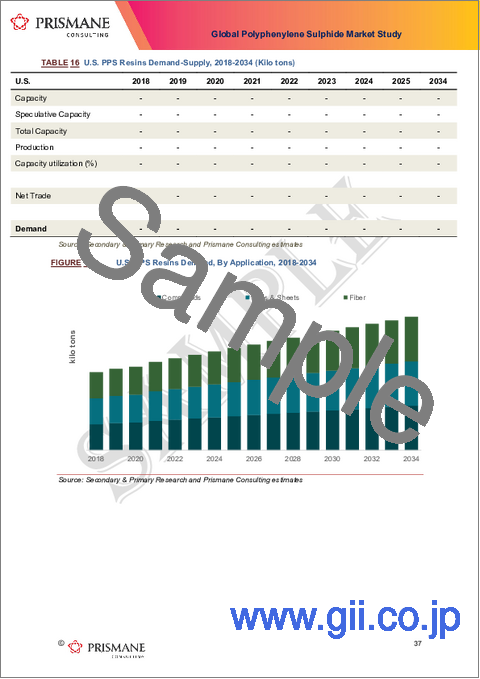|
|
市場調査レポート
商品コード
1761701
ポリフェニレンサルファイド(PPS)の世界市場、需要の分析:タイプ別、用途別、予測分析(2034年)Global Polyphenylene Sulfide (PPS) Market and Demand Analysis, By Types, By Applications [Automotive, Aerospace, Filter Media, Electrical & Electronics] & Forecast Analysis, 2034 |
||||||
|
|||||||
| ポリフェニレンサルファイド(PPS)の世界市場、需要の分析:タイプ別、用途別、予測分析(2034年) |
|
出版日: 2025年05月06日
発行: Prismane Consulting
ページ情報: 英文 144 Pages
納期: 3~5営業日
|
全表示
- 概要
- 目次
世界のPPSの市場規模は、2024年に17億米ドルであり、2032年までに32億米ドルを超えると予測され、予測期間にCAGRで6.6%の成長が見込まれます。その頑丈な性能は、配合と製造における技術革新もあり、PPSを次世代産業用途の戦略的材料としています。
ポリフェニレンサルファイド(PPS)は高性能な熱可塑性プラスチックで、耐薬品性、熱安定性、機械的強度のユニークな組み合わせにより、着実に名を上げてきました。1970年代初頭にChevron Phillipsによって商業化されたPPSは、現在では先進の材料特性が重要となる自動車や電気・電子を中心としたさまざまな産業で広く採用されています。ポリエーテルエーテルケトン(PEEK)やポリエーテルイミド(PEI)のような代替品に比べ、性能とコストの両面で優位性を持つ汎用性の高いエンジニアリングプラスチックとして、PPSはさまざまな世界市場で需要が拡大し続けています。
市場力学と市場促進要因
PPS市場の成長の主な促進要因は、自動車部門と電気・電子部門での急速な採用であり、金属や従来のプラスチックに取って代わるPPSの価値はますます高まっています。自動車製造では、PPSは熱、摩擦、化学品への曝露が重要な懸念となる、高性能ボンネット内部品に使用されています。自動車メーカーが燃費と排ガス目標を達成するために軽量化戦略を追求する中、PPSは耐久性や安全性を損なうことなく、金属部品の代替を可能にする重要なイネーブラーとして浮上しています。
もう1つの重要な最終用途部門である電気・電子産業では、コネクター、スイッチ、絶縁素子など、精密な成形と高温・腐食環境への耐性が求められる部品にPPSが利用されています。もう1つの重要な用途であるフィルターメディアは、現在世界のPPS消費の約18%を占めており、CAGRで8%と大きく成長しています。軽量でありながら弾力性のある材料を要求する航空宇宙・防衛における新たな機会は、PPSの需要をさらに押し上げると予測され、このセグメントは2032年までに市場の13%に達すると推定されています。
PEEKやPEIが特定の指標において優れた性能を発揮する一方で、PPSは依然としてコスト効率の高い選択肢であり、特に価格を重視する産業では「庶民のPEEK」と呼ばれることも多いです。このポリマーは射出成形が可能で、30~60%のフィラーを配合することができるため、さまざまな産業用途での使い勝手がさらに向上しています。
地域の需要の考察
需要の点では、アジア太平洋が2024年のPPSの最大消費国であり、世界の消費の75%超を占め、中国だけで40%超を占めています。この地域のリーダーシップは、自動車と電子における広大な製造基盤に加え、継続的なインフラ投資と有利な政策支援に起因しています。中国市場は2032年まで年平均7%の成長率を維持すると予測されています。
西欧は、強力な自動車と産業の基盤により、PPS需要で第2位となっています。北米は、自動車、航空宇宙、工業加工部門での継続的な需要に支えられ、僅差でこれに続きます。一方、中東欧、ラテンアメリカ、中東・アフリカの市場シェアは小さいですが、これらの新興地域では工業化とインフラ開発が続いており、潜在的な成長機会があります。
用途の内訳と需要動向
2024年、エンジン部品、ブレーキシステム、冷却部品、パワートレイン用途での使用により、自動車部門が世界のPPS需要の40%超という最大のシェアを占めています。電気自動車(EV)が市場シェアを拡大し続ける中、EV用バッテリー部品、充電コネクター、軽量構造部品におけるPPSの使用も増加しています。
電気・電子部門もこれに続き、スイッチ、ソケット、リレー、ボビン、その他の熱的に重要な用途でPPSが使用されています。難燃性と高い誘電特性を持つPPSは、5G、IoT、コンシューマーエレクトロニクスを含む最新の電子システムに最適です。
PPSはまた、発電所、セメント工場、廃棄物焼却炉など、過酷な化学的・熱的環境下での作業を支える産業用フィルターメディアにも大いに応用されています。航空宇宙・防衛は現在小規模な部門ですが、先進の軽量複合材料の需要により、急成長が予測されます。
当レポートでは、世界のポリフェニレンサルファイド(PPS)市場について調査分析し、市場力学と産業動向、各セグメントの需要、メーカーのプロファイルなどの情報を提供しています。
目次
第1章 イントロダクション
第2章 市場の要約
- 市場の進化
- 需要の概要
- 産業構造
- 戦略上の問題
- 最終用途の動向
- 成長予測
第3章 経済とエネルギーの見通し
- GDPと人口動態
- 金融政策と財政政策
- 原油生産と価格
- 天然ガス
- 電気料金
第4章 最終用途部門の実績
- 自動車
- 工業
- 航空宇宙
- 電気・電子
- その他
第5章 ポリフェニレンサルファイド(PPS)のイントロダクションと市場の概要
- 製品の説明
- グレードと特性
- 原材料
- 製造プロセス
- 環境問題
- バリューチェーン
- 用途
第6章 市場力学と産業動向
- 市場力学
- 促進要因
- 抑制要因
- 機会
- 課題
第7章 世界のポリフェニレンサルファイド(PPS)需要の分析:用途別(数量と金額)(2018年~2034年)
- 戦略上の問題とCOVID-19の影響
- 需要の分析と予測(2018年~2034年)
- 需要
- 需要成長率
- 促進要因の分析
- 世界のポリフェニレンサルファイド(PPS)市場:用途別
- 自動車
- 工業
- 航空宇宙
- フィルターメディア
- 電気・電子
- その他
第8章 需要の分析と市場のレビュー:地域/国別(数量と金額)(2018年~2034年)
- 戦略上の問題とCOVID-19の影響
- 需要の分析と予測(2018年~2034年)
- 需要
- 需要成長率
- ポリフェニレンサルファイド(PPS)市場:用途別
- 北米
- 米国
- カナダ
- メキシコ
- 西欧
- ドイツ
- フランス
- イタリア
- 英国
- スペイン
- その他の西欧
- 中欧・東欧
- ロシア
- ポーランド
- その他の中欧・東欧
- アジア太平洋
- 中国
- 日本
- インド
- 韓国
- その他のアジア太平洋
- 中南米
- 中東・アフリカ
第9章 価格分析
第10章 主な戦略上の問題と事業機会の評価
- 市場の魅力の評価
- 見通しとターゲット市場の調査
第11章 戦略的推奨と提案
第12章 企業分析
- ポリフェニレンサルファイド(PPS)メーカーのプロファイル/企業分析
- 基本詳細
- 本社、主要市場
- 所有
- 企業の財務
- 製造拠点
- 世界の売上
- 総従業員数
- 製品ポートフォリオ/サービス/ソリューション
- 採用された主な事業戦略とPrismane Consultingの概要
- 近年の発展
- 対象企業
- Solvay SA
- Fortron Industries
- DIC Corporation
- Kureha Corporation
- Toray Industries Inc.
- Tosoh Corporation
- Lion Idemitsu Composites
- SK Chemicals
- Zhejiang NHU Special Materials co., Ltd.
- その他のメーカー
第13章 付録
The global PPS market was valued at USD 1.7 billion in 2024 and is anticipated to surpass USD 3.2 billion by 2032, growing at a CAGR of 6.6% during the forecast period. Its robust performance, coupled with innovation in compounding and manufacturing, positions PPS as a strategic material for next-generation industrial applications.
Polyphenylene Sulfide (PPS) is a high-performance thermoplastic that has steadily risen to prominence due to its unique combination of chemical resistance, thermal stability, and mechanical strength. Commercialized in the early 1970s by Chevron Phillips, PPS is now widely adopted in diverse industries, especially automotive and electrical & electronics, where advanced material properties are critical. As a versatile engineering plastic that offers both performance and cost advantages compared to alternatives like Polyether Ether Ketone (PEEK) or Polyetherimide (PEI), PPS continues to capture growing demand in various global markets.
PPS is primarily produced using para-dichlorobenzene (p-DCB) and sodium hydrosulfide, both of which carry environmental concerns related to toxicity and groundwater contamination. The chemical-intensive manufacturing process has led to scrutiny, especially in North America and Europe, where regulatory pressures are tightening. For instance, the U.S. Environmental Protection Agency (EPA) has listed several legacy chlorinated solvent sites under Superfund designation, allocating multimillion-dollar clean-up budgets.
Market Dynamics and Key Drivers
The primary driver of PPS market growth is its rapid adoption in the automotive and electrical & electronics sectors, where its ability to replace metals and conventional plastics proves increasingly valuable. In automotive manufacturing, PPS is used in high-performance under-the-hood components, where heat, friction, and chemical exposure are significant concerns. As vehicle manufacturers pursue lightweighting initiatives to meet fuel economy and emissions targets, PPS has emerged as a critical enabler for replacing metal components, without compromising durability or safety.
The electrical and electronics industry, another key end-use segment, leverages PPS for components like connectors, switches, and insulation elements that require precision molding and resistance to high temperatures and corrosive environments. Filter media, another important application, currently accounts for approximately 18% of global PPS consumption and is growing at a notable CAGR of 8%. The emerging opportunities in aerospace and defense, which demand lightweight yet resilient materials, are expected to push PPS demand further, with projections estimating this segment to reach 13% of the market by 2032.
While PEEK and PEI offer superior performance on certain metrics, PPS remains a more cost-effective option, often dubbed the "common man's PEEK," particularly in price-sensitive industries. The polymer's ability to be injection molded and compounded with fillers between 30-60% further enhances its usability across various industrial applications.
Key Competitors
As of 2024, global PPS production capacity stands at around 163 kilo tons and is forecasted to exceed 200 kilo tons by 2032. The market is dominated by several key players including Toray Industries, DIC Corporation, Solvay SA, Fortron Industries, Kureha Corporation, Tosoh Corporation, Lion Idemitsu Composites, and SK Chemicals. Toray Industries leads the global PPS market with an 18% share of installed capacity, followed by DIC Corporation at 15%.
Asia-Pacific emerges as the world's largest PPS producer, accounting for three-fourths of global capacity in 2024. The region's dominance is expected to grow further with new capacity additions, particularly in China, Japan, and South Korea. Toray Industries has announced expansions at its Gunsan facility in South Korea and Iwaki plant in Japan, which will bring its total PPS capacity to 32.6 kilo tons globally. These expansions, slated for completion by 2025, are designed to address the rising demand in automotive and electronics, especially in Asia's fast-growing economies.
Regional Demand Insights
In terms of demand, Asia-Pacific was the largest consumer of PPS in 2024, accounting for over 75% of global consumption, with China alone contributing more than 40%. The region's leadership stems from its vast manufacturing base in automotive and electronics, as well as continued infrastructure investments and favorable policy support. The Chinese market is projected to maintain an average annual growth rate of 7% through 2032.
Western Europe ranks second in PPS demand, driven by its strong automotive and industrial base. North America follows closely, supported by ongoing demand in automotive, aerospace, and industrial processing sectors. Meanwhile, Central & Eastern Europe, Latin America, and the Middle East & Africa collectively account for a smaller market share but present potential growth opportunities as industrialization and infrastructure development continue in these emerging regions.
Application Breakdown and Demand Trends
In 2024, the automotive sector held the largest share of global PPS demand at over 40%, due to its use in engine parts, brake systems, cooling components, and powertrain applications. As electric vehicles (EVs) continue gaining market share, PPS use in EV battery components, charging connectors, and lightweight structural parts is also growing.
The electrical & electronics sector follows closely, with PPS used in switches, sockets, relays, bobbins, and other thermally critical applications. Its flame retardant and high dielectric properties make it ideal for modern electronic systems, including those in 5G, IoT, and consumer electronics.
PPS also finds significant application in industrial filter media, where it supports operations in harsh chemical and thermal environments such as power plants, cement factories, and waste incinerators. Aerospace & defense, though a smaller segment currently, is forecasted to grow rapidly, driven by demand for advanced lightweight composites.
Table of Contents
1. Introduction
- Scope
- Market Coverage
- Application
- Regions
- Countries
- Years Considered
- Historical - 2018 - 2023
- Base - 2024
- Forecast Period - 2025 - 2034
- Research Methodology
- Approach
- Research Methodology
- Prismane Consulting Market Models
- Assumptions & Limitations
- Abbreviations & Definitions
- Conversion Factors
- Data Sources
2. Market Synopsis
- Market Evolution
- Demand Overview
- Industry Structure
- Strategic Issues
- End-use Trends
- Growth Forecast
3. Economic & Energy Outlook
- GDP and Demographics
- Monetary & Fiscal Policies
- Crude Oil Production and prices
- Natural Gas
- Electricity Prices
4. End-use Sector Performance
- Automotive
- Industrial
- Aerospace
- Electrical & Electronics
- Others
5. Introduction to Polyphenylene Sulfide (PPS) and Market Overview
- Product Description
- Grades & Properties
- Raw Material
- Manufacturing Process
- Environmental Issues
- Value Chain
- Applications
6. Market Dynamics and Industry Trends
- Market Dynamics
- Drivers
- Restraints
- Opportunities
- Challenges
7. Global Polyphenylene Sulfide (PPS) Demand Analysis, By Application (Volume, Value) (2018-2034)
- Strategic Issues and COVID-19 Impact
- Demand Analysis and Forecast (2018- 2034)
- Demand
- Demand Growth Rate (%)
- Driving Force Analysis
- Global Polyphenylene Sulfide (PPS) Market, By Application
- Automotive
- Industrial
- Aerospace
- Filter Media
- Electrical & Electronics
- Others
8. Demand Analysis and Market Review, By Region, By Country (Volume, Value), (2018- 2034)
- Strategic Issues and COVID-19 Impact
- Demand Analysis and Forecast (2018 - 2034)
- Demand
- Demand Growth Rate (%)
- Polyphenylene Sulfide (PPS) Market, By Application
Note: Demand Analysis has been provided for all major Regions / Countries as mentioned below. The demand (consumption) split by application has been provided for each of the countries / regions in Volume (Kilo tons) and Value (USD Million).
- North America
- USA
- Canada
- Mexico
- Western Europe
- Germany
- France
- Italy
- United Kingdom
- Spain
- Rest of Western Europe
- Central & Eastern Europe
- Russia
- Poland
- Rest of Central & Eastern Europe
- Asia-Pacific
- China
- Japan
- India
- South Korea
- Rest of Asia-Pacific
- Central & South America
- Middle East & Africa
Note: CAGR will be calculated for all the applications to arrive at the regional / global demand growth for the forecast period (2025 - 2034)
9. Pricing Analysis
10. Key Strategic Issues and Business Opportunity Assessment
- Market Attractiveness Assessment
- Prospective & Target Market Study
11. Strategic Recommendation & Suggestions
12. Company Analysis
- Polyphenylene Sulfide (PPS) Manufacturers Profiles/ Company Analysis
- Basic Details
- Headquarter, Key Markets
- Ownership
- Company Financial
- Manufacturing Bases
- Global Turnover
- Total Employee
- Product Portfolio / Services / Solutions
- Key Business Strategies adopted and Prismane Consulting Overview
- Recent Developments
- Companies Covered -
- Solvay SA
- Fortron Industries
- DIC Corporation
- Kureha Corporation
- Toray Industries Inc.
- Tosoh Corporation
- Lion Idemitsu Composites
- SK Chemicals
- Zhejiang NHU Special Materials co., Ltd.
- Other Manufacturers
Note: This section includes company information, company financials, manufacturing bases and operating regions. Company financials have been mentioned only for those companies where financials were available in SEC Filings, annual reports, or company websites. All the reported financials in this report are in U.S. Dollars. Financials reported in other currencies have been converted using average currency conversion rates. Company profiles may include manufacturers, suppliers, and distributors.
13. Appendices
- Demand - Regions
- Demand - Countries





